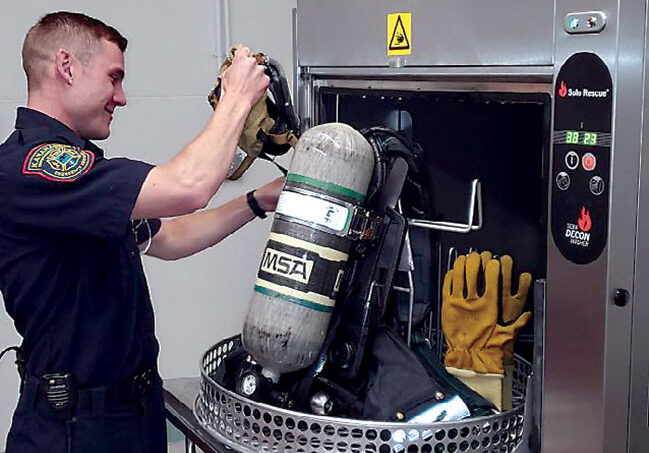
Firefighter health first: Innovations in PPE decontamination
By Jamie Little and Ross Humphry
Features canadian firefighter Equipment firefighter firefighter training wellness Senior Firefighter Tristan Hagedorn at Kananaskis Emergency Services loading the washer for first use.
Photo: Kananaskis Emergency Services
Senior Firefighter Tristan Hagedorn at Kananaskis Emergency Services loading the washer for first use.
Photo: Kananaskis Emergency Services A firefighter’s bunker gear, SCBAs (self-contained breathing apparatus), boots, gloves and helmets are subjected to a variety of carcinogens found in the smoke and residue from fires. It’s a fact that these cancer-causing PAH (polycyclic aromatic hydrocarbons) particulates have been found in their bunker gear and personal protective equipment (PPE) for decades.
As an increasing number of fire departments have become aware of this hazard, the question was: how can firefighters properly clean their gear, and what can be done to help them do this safely?
Up until recently, fire departments cleaned their helmets, boots and gloves by hand. This was a labour-intensive effort that subjected the firefighters to undue exposure to these cancer-causing materials. With researching proving that carcinogens are also absorbed through the skin, rather than just breathing them in, this was a dangerous task for fire service personnel. For these reasons, some firefighters would decide not to clean their PPE. If they did clean their PPE, it led to inconsistencies within the department and, unfortunately, the equipment was not being cleaned the way it should be. This led to firefighters cross contaminating their stations and apparatus with carcinogenic materials.
“In the past, firefighters would receive one set of bunker gear, and these would be sent away as required to be cleaned and repaired. The SCBAs were never sent off, and on the rare occasion they were washed by hand, the quality of the wash was not the best. Nowadays, some fire halls are purchasing two sets of bunker gear for their firefighters, but that’s a hefty cost,” said Ross Humphry.
A firefighter’s health is of the utmost importance, and new technologies are needed to keep them and their gear in tip top shape.
NFPA 1851 (Standard on Selection, Care and Maintenance of Protective Ensembles for Structural Fire Fighting and Proximity Fire Fighting) and NFPA 1852 (Standard on Selection, Care, and Maintenance of Open-Circuit Self-Contained Breathing Apparatus (SCBA)) are the two NFPA standards that define how to properly clean your PPE including helmets, boots, gloves and SCBAs. These are written by technical committees whose members are the subject matter experts in their respective fields. Following these standards is critical to any fire department as they provide them with safe and effective cleaning methods. Choosing not to follow these could risk damage to the PPE and could cause death in a worst-case scenario.
In the last few years, new technologies have been created to address this urgent need for properly cleaned PPE, one such technology being the Solo Rescue Decon Washer. The most important aspect, aside from decontamination, was that these technologies needed to purpose-built for the job at hand, to keep firefighters safe in their gear.
These new washers were designed to meet the requirements of both NFPA 1851 and 1852. Using a high-pressure rotating basket system to clean the SCBAs, masks and cylinders, an eight-minute wash aims to clear out the harmful cancer-causing particulates.
“Even after cleaning the gear by hand to the NFPA standards, they assumed it was clean. But when they put the same gear into the washer and did testing of the water afterwards, it was proven that the hand-washing did not remove all of the PAH particles,” said Humphrey.
These technologies have started appearing in the Canadian fire service, with over 50 departments putting them into service. Kananaskis Emergency Services in Alberta was the first in Canada to adopt it into their station. Captain Gary Robertson shared, “We have collaborated closely over the last four years … to bring this innovation in firefighter decontamination not only to our organization, but the Canadian fire service. … The contaminants that were removed from SCBA’s that had previously been cleaned by hand washing was astonishing.”
A firefighter’s health is of the utmost importance, and new technologies are needed to keep them and their gear in tip top shape. This is just the beginning of the future of decontamination for the fire service.
Jamie Little is a NFPA Respiratory Protection Equipment Committee member and the director of market development at Rescue Intellitech.
Ross Humphry is the president of Canadian Safety Equipment.
Print this page
Advertisement
- Communication system used by Montreal police, firefighters suffers outage overnight
- Ontario launches accredited Fire Safety Certification program